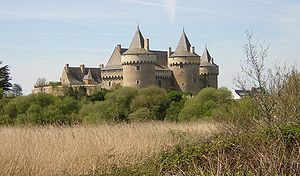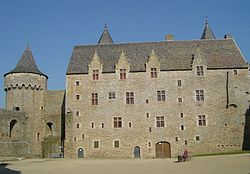- Château de Suscinio
-
The Château de Suscinio or de Susinio is a French castle, built in the late Middle Ages, to be the residence of the Dukes of Brittany. It is located near the town of Sarzeau in the département of Morbihan, near the coast of the Atlantic ocean. The spectacular site comprises the moated castle, a ruined chapel, a dovecote, and a few ruined outbuildings.
Contents
History
Designed to be a place of leisure, between the seaside and a forest full of game for hunting, the castle's first logis seigneurial (seigniorial house) dates from the beginning of the 13th century.
The castle was fortified and enlarged, at the end of 14th century, when the heirs of the duchy had to fight to keep their assets (Brittany was not yet part of France and did not become so until 1514), after the castle was taken by Bertrand du Guesclin, the infamous Constable of France. John V and John VI constructed a new seigniorial residence block with a large, new corner tower known as the Tour Neuve. A casemate was added at the end of 15th century to protect artillery pieces.
Suscinio and the English Wars of The Roses: - Between 1471 until 1483, the Castle housed Jasper & Henry Tudor [later King Henry VII of England] and the core of their group of exiled Lancastrians, estimated to have been some 500-strong by 1483. Since the castle was only capable of housing some 100 persons, the rest must have been billeted close about, in Kermoizin and other villages nearby. Duc Francois II generously supported this group of exiled Englishmen against all the Plantagent demands that he should surrender them. So, for 11 years, Suscinio was an armed camp, alert against any attempt to kidnap Jasper and Henry, and return them to England where they were "under Attainder" and would have been promptly executed, as threats to Yorkist Rule. After the failed Lancastrian rebellion and invasion of England in 1483, which Duc Francois supported to the tune of 40,000 gold crowns, 15,000 soldiers, and a fleet of transport ships, - the Duc suffered one of his periods of incapacitating illness, and his hated Treasurer Pierre Landois - who promptly abrogated the Ducal power to himself in his Liege Lord's name, - without his Lord's approval, - agreed to surrender Henry Tudor to the representatives of King Richard III, in reurn for a pledge of 3,000 English Archers to defend Breton Borders against a threatened French attack. News of this plot by Landois reached the exiled Lancastrians just in time for both the Tudors to separately escape across the nearby border into France [only hours ahead of Landois' soldiers]; and to the hospitality of King Charles VIII, who received them at his Court. When Duc Francois II regained his faculties shortly thereafter, he offered the remaining Lancastrians [some 400 men] still at- and around- Suscinio safe-conduct into France, and even gave them monies to pay their expenses. This may have been the last official use of the castle by the Breton Dukes. Duc Francois II died in 1488, to be succeeded at the age of only 11 years, by his daughter, Anne of Brittany, last Ruling Duchess, and twice Queen of France. She died in 1514 and Brittany lost its autonomy, becoming part of France.
The castle was then slowly abandoned by the aristocracy. In the early sixteenth century, the former great hall of the 14th century along the northern curtain-wall, was destroyed. The castle was then confiscated by the French crown under Francis I who offered it to one of his mistresses. In 1795, Sucinio was temporarily occupied by the royalists coming from Quiberon and heading to the north of the department. Written off in the 17th and 18th centuries, the castle was used off-and-on as a stone quarry until the Revolution.
During the Revolution, it was sold to a merchant who continued to sell the stones, and it fell into even greater ruin.
The restoration
The Département of Morbihan bought it in 1965, from the family of Jules de Francheville who attempted to preserve and restore the castle, and began the restoration in earnest. The remains of a ducal chapel was found in the vicinity outside of the moats; its remarkable tiled floor has been carefully removed and restored and is now exhibited in a hall of the castle.
Nowadays, Suscinio Castle has again regained its allure of an intact medieval fortress, but major restoration work continues.
The castle may be unique in W.Europe because of its restoration to its presumed late-15th century condition; because many other medieval fortresses made obsolete by the use of cannon in warfare were either dismantled or modernised to become "comfortable country houses". In this 3rd Millennium, few other medieval fortresses remain, structurally, as they were at the height of their late-medieval strength and power; and in this lies the particular interest of the Chateau de Suscinio. .
Exhibitions and summer events attract many people. Since 1840, the castle has been listed as a monument historique by the French Ministry of Culture.
See also
External links
Coordinates: 47°30′46″N 2°43′46″W / 47.51278°N 2.72944°W
- This article incorporates information from this version of the equivalent article on the French Wikipedia.
Categories:- Châteaux in France
- Buildings and structures in Morbihan
- Official historical monuments of France
Wikimedia Foundation. 2010.



